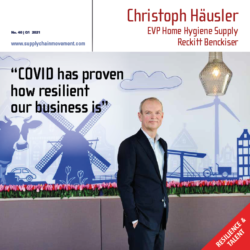Controversial discussion: just how beneficial is forecasting?

Which market signals affect future demand, and how can you measure them? And just how beneficial is a statistical forecast? These pressing issues were discussed at length during the first keynote and panel discussion on S&OP Flavour Day. “S&OP is often seen as the silver bullet,” said discussion leader Jonathon Karelse. “Companies including Assa Abloy and LKQ Europe can tell you what it’s really like.”
By Harm Beerens
“Connecting market demand with S&OP’ was the theme of the event, which was organized by Supply Chain Media. How can you forecast demand and link it to supply chain planning? Plenty can be said about that. In fact, keynote speaker Jonathon Karelse has written a book about it, called ‘Histories of the Future’. Among other things, he addresses the question of an optimal forecasting model. “Some people love nothing better than coming up with the ultimate optimally mathematical forecasting model. But to me, forecasting is nothing more than an enabler to help your company meet its financial goals. I always ask people who are constantly trying to improve the reliability of their forecasts ‘How much money do you think you can save by doing that?’. In other words, unless you know how a better forecast will benefit your company financially, I wouldn’t bother spending any energy on it.”
Embarrassing realization
 It became apparent just how controversial the topic of forecasting can be during the panel discussion, which besides Karelse included Danny van der Ster from Assa Abloy and Nicole Miara (pictured) from LKQ Europe. The latter gave a stark example: “I know a large multinational company that worked with the most advanced forecasting system and employed the best planners. When they analysed their historic forecast reliability, they discovered that they might as well have used a simple ‘moving average’ forecast model. All those expensive systems and processes had contributed absolutely nothing, which of course was a rather embarrassing realization.” Karelse added: “As the legendary forecasting expert Georg Box once said, ‘Essentially all models are wrong, even the most sophisticated ones, but some are useful’.”
It became apparent just how controversial the topic of forecasting can be during the panel discussion, which besides Karelse included Danny van der Ster from Assa Abloy and Nicole Miara (pictured) from LKQ Europe. The latter gave a stark example: “I know a large multinational company that worked with the most advanced forecasting system and employed the best planners. When they analysed their historic forecast reliability, they discovered that they might as well have used a simple ‘moving average’ forecast model. All those expensive systems and processes had contributed absolutely nothing, which of course was a rather embarrassing realization.” Karelse added: “As the legendary forecasting expert Georg Box once said, ‘Essentially all models are wrong, even the most sophisticated ones, but some are useful’.”
Picking up on market signals
Besides having a useful statistical forecasting model, it is important for a company to pick up the right signals from the market: signals that may indicate an upcoming change in demand. But that too is controversial, it turned out during the discussion, because what do those signals say? “Take inflation, for example,” said Miara from LKQ, Europe’s largest automotive spare parts distributor. “Everyone will agree that inflation affects demand, but what will be the actual impact? Will the demand for spare parts fall because prices are going up? Or will it increase because people will hold on to their existing cars for longer?”.
For Assa Abloy, which sells solutions for doors and loading docks worldwide, the situation in the UK is an important market signal, according to Van der Ster. “Somehow, the UK is always a step ahead of the rest of the world in our sector. If demand starts to drop there, we know that the rest of the countries will follow – some regions soon afterwards and others much later, but eventually demand is going to change everywhere.”
Beware of the bullwhip
 The COVID-19 crisis was perhaps the most controversial event in the history of forecasting. All statistical models became worthless and misjudged demand led to bullwhip effects that are continuing to affect entire industries (e.g. e-bikes) today. “Understanding how bullwhips resonate throughout your supply chain and how this impacts on demand has been one of the biggest lessons I’ve learned in recent years,” stated Miara. One lesson Van der Ster (pictured) learned from the pandemic is to focus less on worrying about when demand will actually change, and more on how you are going to respond. “For us, agility is more important than effective forecasting. We knew that there would be a tipping point after the peak during COVID. It’s hard to say when exactly, but the most important thing is to know what to do when it happens.”
The COVID-19 crisis was perhaps the most controversial event in the history of forecasting. All statistical models became worthless and misjudged demand led to bullwhip effects that are continuing to affect entire industries (e.g. e-bikes) today. “Understanding how bullwhips resonate throughout your supply chain and how this impacts on demand has been one of the biggest lessons I’ve learned in recent years,” stated Miara. One lesson Van der Ster (pictured) learned from the pandemic is to focus less on worrying about when demand will actually change, and more on how you are going to respond. “For us, agility is more important than effective forecasting. We knew that there would be a tipping point after the peak during COVID. It’s hard to say when exactly, but the most important thing is to know what to do when it happens.”
That brought the speakers onto the main topic of the day: Sales & Operations Planning. How can you use the forecast to create a demand plan and arrive at the right purchasing and production decisions? Miara’s tip was to always use a balanced scorecard when making decisions. “Individual departments have their own KPIs and will act accordingly. Therefore, when making a decision, provide visibility into the impact on the cost of goods sold or the gross profit margin. That way, you’re more likely to make decisions that are optimal for the entire chain.”
S&OP is not a silver bullet
Karelse cautioned against underestimating the implementation of S&OP. “In my experience, supply chain directors sometimes see S&OP as a silver bullet: an instrument that will solve all their supply chain problems in one go. But as we’ve just heard, it’s not that simple. Here at this event, you can meet software vendors offering great S&OP solutions. Talk to them for inspiration, and also listen to companies like Assa Abloy and LKQ. They can tell you what it’s really like.”










